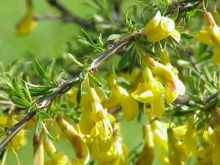
Pygmy marmosets are two species of small New World monkeys in the genus Cebuella. They are native to rainforests of the western Amazon Basin in South America. These primates are notable for being the smallest monkeys in the world, at just over 100 g (3.5 oz). They are generally found in evergreen and river-edge forests and are gum-feeding specialists, or gummivores.

Caragana is a genus of about 80–100 species of flowering plants in the family Fabaceae, native to Asia and eastern Europe.
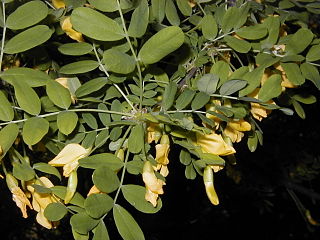
Caragana arborescens, the Siberian peashrub, Siberian pea-tree, or caragana, is a species of legume native to Siberia and parts of China and neighboring Mongolia and Kazakhstan. It was taken to the United States by Eurasian immigrants, who used it as a food source while travelling west. In some areas of the United States it is considered an invasive species. Introduced on the Canadian prairies in the 1880's, the hardy caragana provided shelter-belts, wildlife habitat, nitrogen fixation, and wind-breaks to prevent soil erosion and snow drifting.
Microhyla borneensis, also known as the Matang narrow-mouthed frog, is a species of microhylid frog found in the Matang Range in Sarawak, Borneo. It was once the smallest known frog from the Old World. Adult males of this species have a snout-vent length (SVL) of 10.6–12.8 mm (0.42–0.50 in), but adult males can reach a maximum of 13 mm (0.51 in),and adult females of this species have a snout-vent length of 16–19 mm (0.63–0.75 in), Tadpoles measure just 3 mm.

Caragana halodendron is a species of flowering plant in the pea family (Fabaceae). It is known by several common names, including common salt tree and Russian salt tree. It is native to Russia and southern Asia, but it can be found on other continents where it is an introduced species, and one that is often a noxious weed. This is a deciduous spiny shrub sprawling to a few meters in maximum width and up to three meters tall. Stems branch from the base and bear clusters of about four leaflets on sharp spurs. The ends of branches narrow to spines. Flowers also appear at the ends of spurs in clusters of two to four pink pealike blossoms each one to two centimeters wide. The fruit is a black woody inflated pod about 2 centimeters long containing legume seeds. The plant has a deep and wide root system, with the lateral roots sending up new shoots. In this manner the plant forms extensive thickets. When introduced to an area of suitable climate, such as California where it is a known weed, it can invade cultivated land and spread relatively quickly. It is tolerant of saline soils.

Calophaca is a genus of flowering plants in the legume family, Fabaceae. It includes nine species, which range from Ukraine through southern Russia and Central Asia to Xinjiang and Pakistan. It belongs to the subfamily Faboideae and is closely related to the genus Caragana. Nine species are accepted:
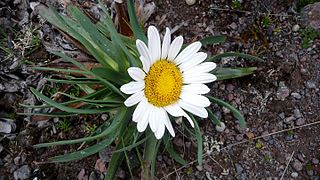
Werneria is a genus of South American plants in the groundsel tribe within the sunflower family.

α-Viniferin is a stilbene trimer. It can be isolated from Caragana chamlagu and from Caragana sinica and from the stem bark of Dryobalanops aromatica. It is also present in relation to resistance to Botrytis cinerea and Plasmopara viticola in Vitis vinifera and Vitis riparia. It has been shown to inhibit acetylcholinesterase.
Coleophora kaszabi is a moth of the family Coleophoridae. It is found in Mongolia.
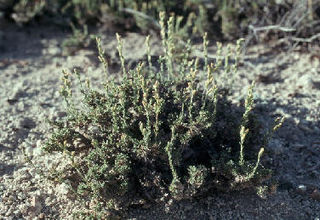
Artemisia pygmaea is a North American species of sagebrush in the aster family known by the common name pygmy sagebrush.
Calyptridium pygmaeum, synonym Cistanthe pygmaea, common name pygmy pussypaws, is a plant species endemic to California. It has been reported from Riverside, San Bernardino, Inyo, Tulare and Fresno Counties, in pine and subalpine forests at elevations of 1900–3550 m.
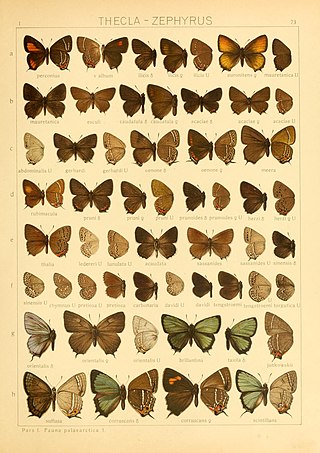
Neolycaena davidi is a small butterfly found in the East Palearctic that belongs to the lycaenids or blues family.
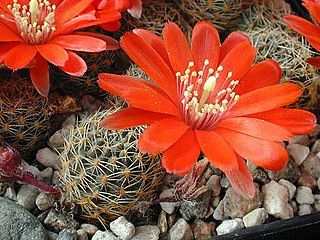
Aylostera pygmaea, synonyms including Rebutia pygmaea, is a species of cactus in the genus Aylostera, native to Bolivia and northwest Argentina. It has gained the Royal Horticultural Society's Award of Garden Merit.
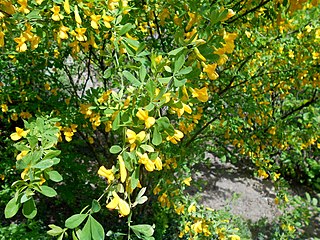
Caragana frutex is a species of flowering plant belonging to the family Fabaceae.
Caragana korshinskii, also known as the Korshinsk pea shrub, is a shrub from the genus Caragana. The plant is native to sandy grass and desert areas of northern China and Mongolia. This plant is classified as an invasive species and is a minor host of Scolytus schevyrewi. Caragana Korshinskii is utilized in Northern China for both the fixation of sand and soil/water conservation. This plant is found in desert regions of China and is adapted to suit that environment. This adaption is seen in its ability to survive under conditions prone to salty, cold, and dry conditions.
Fryxellia is a monotypic genus of flowering plants belonging to the family Malvaceae. It contains only one species, Fryxellia pygmaea(Correll) D.M.Bates.
Megadenia is a genus of flowering plants belonging to the family Brassicaceae.

Symphyotrichum pygmaeum is a species of flowering plant in the family Asteraceae. Commonly known as pygmy aster, it is a perennial, herbaceous plant that may reach heights of 1.5 to 15 centimeters. Its summer-blooming flowers have purple to violet ray florets and yellow disk florets.

Evax pygmaea is a plant species in the family Asteraceae.
